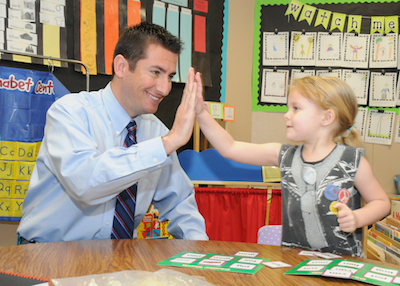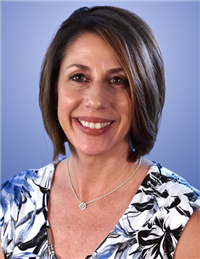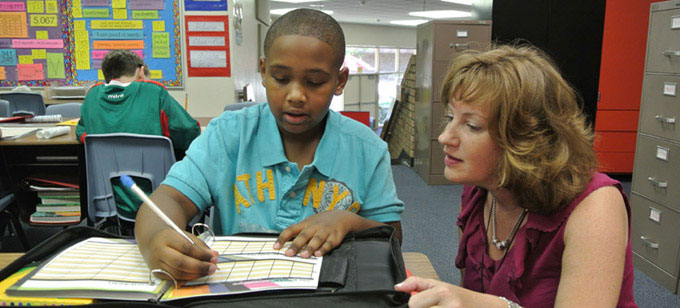
These are not the easiest of times to recruit and retain schoolteachers.
Arizona’s state funding for education remains among the lowest in the country. The talent pool can make more money doing something else.
The pandemic created questions that caused some teachers to step away – whether for family issues, care for their young children, moving out-of-state for a spouse’s job, or for their perceived own protection as a result of rules regarding COVID-19 vaccinations and wearing masks in the classroom.
Yet against that background, the Kyrene and Tempe Elementary school districts, which serve Tempe and West Chandler, opened the new school year at full staffing after scrambling to tweak their teacher recruiting and retention techniques.
 That means that students per classroom are not expected to grow in either district.
That means that students per classroom are not expected to grow in either district.
“We look at this data every single year and try to figure out if there is something that we can do better to retain our teachers,” said Lisa Gibson, Kyrene’s executive director of talent management. “We are very fortunate. We are going to open the school year fully staffed.
“As a former principal, I know what it feels like when you don’t have the staffing that you need, or you’re out looking for a teacher in July. That feels very stressful. We’re ready to go. We are not going to have to collapse any classrooms.”
TEACHER RECRUITERS MUST ‘THINK OUTSIDE THE BOX’
Kyrene employs roughly 1,000 teachers in its 26 schools, which were attended by roughly 16,000 students last school year.
“I guess when we’re thinking about recruiting and retention of teachers, we are really having to think outside the box now in ways to attract and retain people because life is different,” Gibson said.
For example, Kyrene recently made a recruiting commercial with Cox Communications, which created an uptick in applications, Gibson said, and not just for teaching positions. The district has about 1,000 support employees who are not teachers.
“Things were changing prior to the pandemic, but now after the pandemic, the way people get their information, receive their information, and what is important to them is different, so we have to change our practices. We can’t stay the same anymore,” she said. “We are really doing that. We really want to meet their needs: What are people looking for that we have to offer them?”

Kyrene changed everything to a virtual-hiring environment. It traditionally conducted job fairs in Januarys and Februarys, and they typically were large, in-person events.
“Even though I say that was a challenge, it also was helpful because sometimes our people travel to Las Vegas or California or way out east to interview candidates,” Gibson said. “So we didn’t have to pay for those flights — just jump on a Zoom call and interview that way.
“The other piece that was different this year was, because our budget was so tight, we didn’t really do a lot of hiring in our elementary positions. Our focus in recruiting and marketing was in our hard-to-fill positions, which are middle-school content areas, such as middle-school math, middle-school science. And then we also did a lot of recruiting for special-education positions, such as self-contained resources room or even a resource teacher.”
Drilling down on those areas was made possible because Kyrene retained what Gibson said was the highest year-over-year rate ever of teachers, more than 90 percent, “which is very interesting because it happened right during the pandemic.”
“One of our focuses has been: How do we retain employees?” she said. “We want to make sure that our benefits are still good, that teachers have the support that they need, which is so important when you’re a new teacher, make sure we have enough professional growth, provide financial incentives.”
Kyrene offered a stipend for the new school year to all employees. For full-timers, it is $1,000 during the year, $500 in December and another $500 in May, to honor the work they’ve been doing during the pandemic. Starting pay for a first-year teacher with a bachelor’s degree is just under $45,700.
“And our benefits did not show a change this year,” she said. “There weren’t additional deductions or costs for employees, so that was a bonus.”
Michael Minghine, assistant superintendent of administrative services for Tempe Elementary School District, said the district used one-time funding from the Elementary and Secondary School Emergency Relief Fund through the CARES Act to address recruitment and retention challenges for 2021-22, allowing it to increase compensation for all district staff.
All returning Tempe El employees received a 1 percent raise and a $3,000 retention stipend. All employees new to the district get a $3,000 recruitment stipend. Tempe El also increased the Proposition 301 allocation that the district receives from the state to $4,500 from $2,250 for qualified teachers.
Tempe El continues to offer a competitive salary as well as other stipend opportunities for staff working in hard-to-fill specialty position, according to Minghine.
“I am extremely proud of the hard work our Human Resources Department has done during this recruiting season,” Minghine said. “Currently, almost every one of our 23 schools are fully staffed with certified staff for the 2021-2022 school year. We anticipate having all of our vacancies filled by the first day of school.”
Tempe El used its artificial-intelligence platform on its jobs website to engage with candidates 24/7 and continued participating in virtual job fairs in its recruiting efforts.
And, Minghine said, the district, which had roughly 12,000 students last year, relied on “word-of-mouth recruiting and utilizing our reputation as an amazing district. Our Tempe Elementary teachers are our best recruiters.”
SUBSTITUTE-TEACHER NUMBERS LEAVE DISTRICTS WARY
The real concern for both districts is having enough qualified substitute teachers, and both have taken steps to bolster those numbers.
Tempe Elementary is increasing substitute-teacher compensation to $140 per day from $100 in an effort to attract and retain them. For a long-term substitute, it jumps to $170 a day from $120.
 “A reduction in the number of available (in-person) substitute teachers became very apparent during the COVID-19 pandemic,” Minghine said. “We also worked closely with our partner, Educational Services Inc., on marketing campaigns through job sites and social-media platforms to increase our sub pool.”
“A reduction in the number of available (in-person) substitute teachers became very apparent during the COVID-19 pandemic,” Minghine said. “We also worked closely with our partner, Educational Services Inc., on marketing campaigns through job sites and social-media platforms to increase our sub pool.”
Kyrene is switching its substitute-teacher vendor to ESS, which has specialized in placing qualified substitute staff in daily and long-term positions in school districts for two decades.
“We are in the process of recruiting and hiring substitutes,” Gibson said. “We are most likely going to meet our goal before the year starts. We do have a lot of substitutes who are going to be returning to Kyrene. What we do rely on are some of our retired teachers, who come back and sub for us. That is just so comforting to know that when a teacher is out, whether it’s long-term or more than a couple of days, we have someone in those classrooms who is familiar with Kyrene to assist those students and parents.”
In recruiting and retaining full-time teachers, substitutes and even students, both districts say their reputation and track record are invaluable when other districts offer something that Tempe El and Kyrene can’t.
“We have neighboring districts that are not landlocked like ours, that are growing and that really can offer more salary wise, or have some kind of signing bonus, or can match our salaries,” Gibson said. “Unfortunately, we are not in a position to do that. I do try to remind people to think about the positive, as well. I do feel that our benefits are really good in Kyrene and that is what is attractive. It is competitive.
“There is a lot to offer in Kyrene, like our New Teacher Ambassador program. Teachers have the mentoring support that they need, which is so important when you’re a new teacher. We can always be competitive but we are landlocked and we don’t have the growth money others have, so that makes it difficult.”
DISTRICTS ALSO RECRUIT STUDENTS
What teachers found when they got to their classrooms is another issue. Retention is a two-way street, and there is concern how many students will be back and how much knowledge students have retained after a difficult and disruptive 2020-21 school year. Schools were closed, then reopened, then closed again. Online distance learning isn’t for everyone, and some homes did not have computers to open that door for their kids.
 “The Tempe Elementary School District took a very proactive approach to addressing potential issues, specifically focusing on social and emotional support for students and staff, addressing student learning loss and recovery, and addressing a potential loss of student enrollment,” Minghine said.
“The Tempe Elementary School District took a very proactive approach to addressing potential issues, specifically focusing on social and emotional support for students and staff, addressing student learning loss and recovery, and addressing a potential loss of student enrollment,” Minghine said.
The brutal reality for every Arizona public-school district, facing a proliferation of private and charter schools in the age of school choice, is that they also must recruit and retain students. That, too, is competitive. State funding is based on the number of fannies in the seats.
“We are really looking for our kindergarten students to stay with Kyrene,” Kyrene’s Gibson said. “That is one of the areas that we are focusing on, to capture kindergarten students of those families that live in our community. When we can fill those kindergarten classrooms, we know we have those students for at least a year, and then they tend to stay in our school district.”

